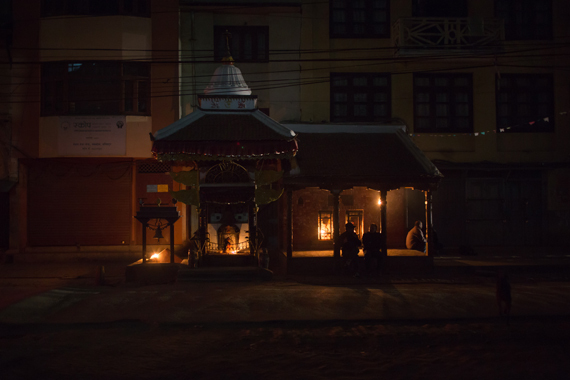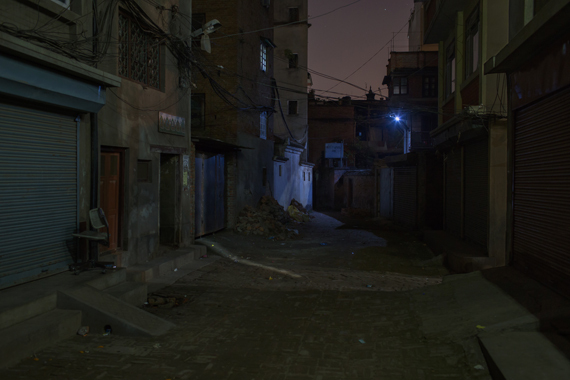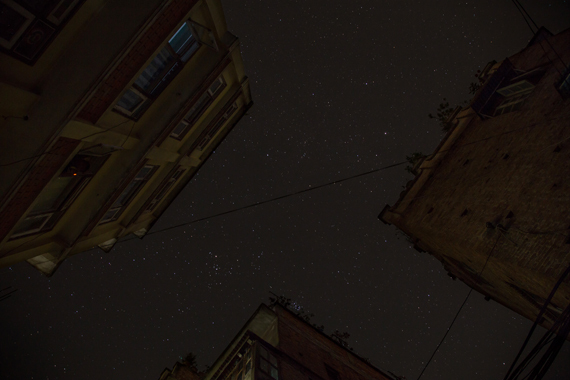It's 7 p.m., but it feels like midnight. The city of Patan in Nepal is already sleeping.
The large city subsumed in the greater Kathmandu area is known to have a calm character compared to the capital's buzz. But as the sun sets, Patan quiets down bafflingly fast.
The reason is electricity, or more precisely, the lack of it.
A couple of construction workers wonder upon a pile of bricks, illuminated by trucks headlights. They communicate quietly. Infrequent mopeds and strollers pass by, even the stray dogs are quietly resting.
Across the street two men are sitting on a candle-lid street side shrine.
All photography by Janne Riikonen
"I would like to see the news at 8 p.m.", Birendra Shakya says and glances at his watch amid the dimness.
He often meets his neighbor, Sudan Ratna Shakya, at evening's dark hours. If Sudan was not available today, Birendra would probably be reading the newspaper by torch or candle light.
In gradually developing Nepal the energy supply does not meet the demand. The deficit of energy is managed with rolling blackouts, which happen for up to 14 hours a day.
The Nepal Electricity Authority (NEA) provides a load shedding schedule, so people can prepare for the power cuts. Yet, the lack of constant electricity "bothers people in all they do", as Birendra Shakya puts it.
"Nepal needs more hydro power plants, that's all. Government is not working hard enough to solve this problem", the frustrated men say.
Men's criticism is understandable. Nepal has many renewable energy possibilities, hydropower and solar energy being the prime options. Nepal has an estimated 42,000 MW of economically feasible hydropower potential, while the peak demand to be load shedding free lies currently around 1,200 MW.
Nepal has a total installed capacity of about 780 MW. During the last fiscal year, NEA's system had total of 4,600 GWh available energy, out of which 1072 GWh was imported from India. But with a net system loss of 25 percent, Nepal falls significantly behind the energy demand.
Governmental institutes seem to be working hard on finding sustainable and alternative solutions to solve the energy crisis in cooperation with development partners such as The World Bank, EU and UNDP.
The Himalayan nation faces massive infrastructural challenges, and less than half of Nepalese have access to the national electric grid. In Nepal's remote areas mini and micro hydro plants generate enough to meet the needs of modestly living rural communities, and solar panels are essential remedy on household-level.
The Nepalese civil war from 1996 to 2006 is considered to be the main reason for today's power shortage. The decade-long war halted the construction of power facilities. In addition the victorious Unified Communist Party of Nepal, also known as Maoists, systematically attacked against the infrastructure, including hydroelectric power plants.
Uddhav Ghimire and Avinash Lama, 16, usually roam around Patan smoking cigarettes during the blackouts.
Today, the Nepalese have adapted many ways to deal with the daily power cuts. At dark hours, torches have replaced kerosene lamps and candles as basic house lights, while drone of generators keep some restaurants and internet cafes running. Birenda Shakya manages to run his metal carving shop with rechargeable batteries.
The Nepalese are fed up, but they manage. As heard in a candle-lit local restaurant in the village of Nagargot, "electricity is a backbone of a developing country".
Sharp at 8 p.m. the power comes back, as it should, according to the schedule. A muffled cheer emanates from the surrounding apartment buildings, and lights can be seen going on through windows.
Birendra Shakya got to see the news, at least today.



